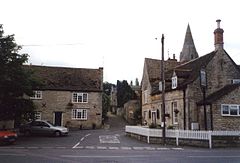Ryhall
| Ryhall | |
|---|---|
 |
|
| Ryhall shown within Rutland | |
| Area | 4.19 sq mi (10.9 km2) |
| Population | 1,614 2011 Census |
| • Density | 392/sq mi (151/km2) |
| OS grid reference | TF036108 |
| • London | 83 miles (134 km) SSE |
| Unitary authority | |
| Ceremonial county | |
| Region | |
| Country | England |
| Sovereign state | United Kingdom |
| Post town | STAMFORD |
| Postcode district | PE9 |
| Dialling code | 01780 |
| Police | Leicestershire |
| Fire | Leicestershire |
| Ambulance | East Midlands |
| EU Parliament | East Midlands |
| UK Parliament | |
Ryhall is a village and civil parish in the county of Rutland in the East Midlands of England. It is situated close to the eastern boundary of the county, about 2 miles (3 km) north of Stamford.
There is an early thirteenth-century parish church, dedicated to St John the Evangelist. The exterior has a number of interesting carved figures. The southern entrance has a porch with a room over it, originally for the priest, now called the Parvis Room.
Saint Tibba, patron saint of falconers, is believed to have lived in Ryhall in the 7th century. She was buried here, but in the 11th century her relics were translated to Peterborough Abbey, now Peterborough Cathedral, by Abbot Ælfsige (1006–1042). According to legend, St Tibba was a niece of King Penda of Mercia. The remains of a small hermitage associated with the saint can be seen on the west side of the north aisle of church.
A 19th-century book refers to a holy well dedicated to Saint Tibba, though the location cannot now be identified, and there is similar doubt about the location of a well said to have been dedicated to Tibba's alleged relative, St Ebba.
The route of the Stamford and Essendine railway passed through the parish, on embankments still clearly visible today. It included a station called "Ryhall & Belmisthorpe", located in Belmesthorpe. The line opened in 1856 but closed a century later in 1959.
In 2011 Ryhall had a population of 1,614, making it one of the largest villages in Rutland. It is bounded to its west by the A6121 main road from Stamford to Bourne and on the other three sides by the River Gwash, although some development has spilled over the river to the north and out along the Essendine road.
...
Wikipedia

